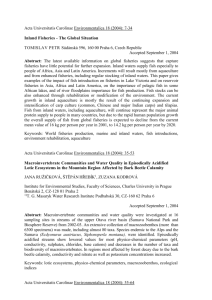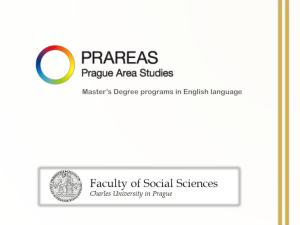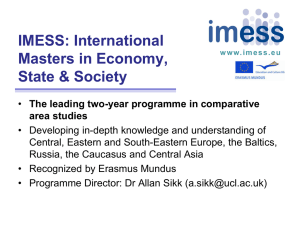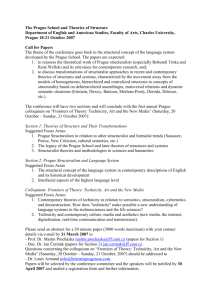AUCE 2006
advertisement
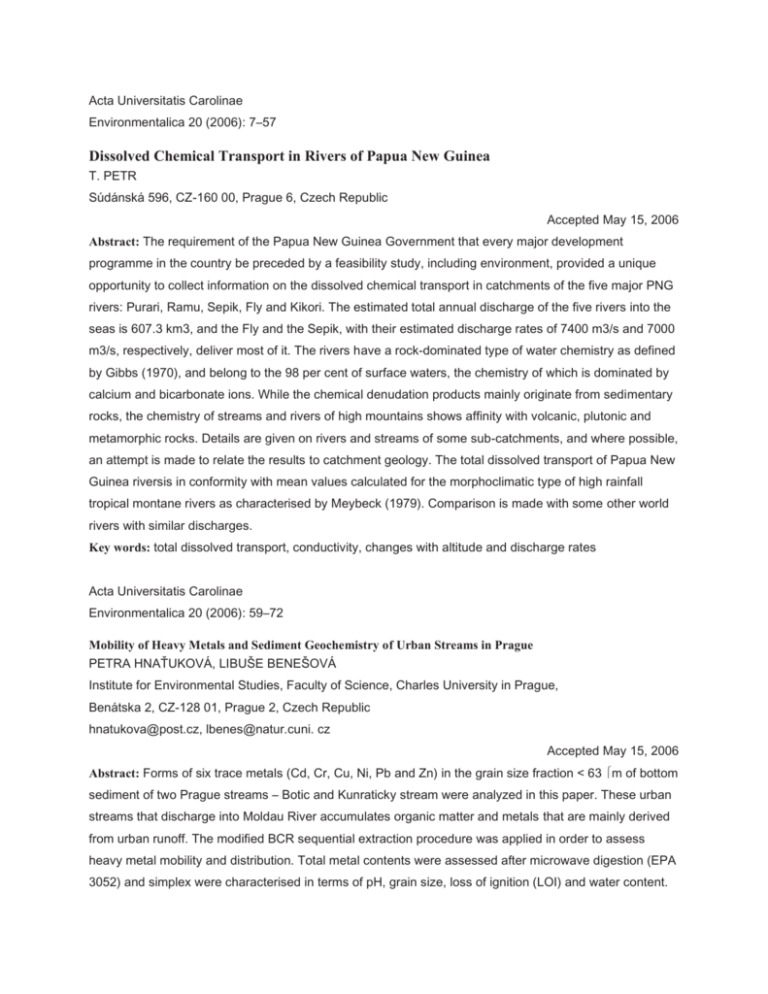
Acta Universitatis Carolinae Environmentalica 20 (2006): 7–57 Dissolved Chemical Transport in Rivers of Papua New Guinea T. PETR Súdánská 596, CZ-160 00, Prague 6, Czech Republic Accepted May 15, 2006 Abstract: The requirement of the Papua New Guinea Government that every major development programme in the country be preceded by a feasibility study, including environment, provided a unique opportunity to collect information on the dissolved chemical transport in catchments of the five major PNG rivers: Purari, Ramu, Sepik, Fly and Kikori. The estimated total annual discharge of the five rivers into the seas is 607.3 km3, and the Fly and the Sepik, with their estimated discharge rates of 7400 m3/s and 7000 m3/s, respectively, deliver most of it. The rivers have a rock-dominated type of water chemistry as defined by Gibbs (1970), and belong to the 98 per cent of surface waters, the chemistry of which is dominated by calcium and bicarbonate ions. While the chemical denudation products mainly originate from sedimentary rocks, the chemistry of streams and rivers of high mountains shows affinity with volcanic, plutonic and metamorphic rocks. Details are given on rivers and streams of some sub-catchments, and where possible, an attempt is made to relate the results to catchment geology. The total dissolved transport of Papua New Guinea riversis in conformity with mean values calculated for the morphoclimatic type of high rainfall tropical montane rivers as characterised by Meybeck (1979). Comparison is made with some other world rivers with similar discharges. Key words: total dissolved transport, conductivity, changes with altitude and discharge rates Acta Universitatis Carolinae Environmentalica 20 (2006): 59–72 Mobility of Heavy Metals and Sediment Geochemistry of Urban Streams in Prague PETRA HNAŤUKOVÁ, LIBUŠE BENEŠOVÁ Institute for Environmental Studies, Faculty of Science, Charles University in Prague, Benátska 2, CZ-128 01, Prague 2, Czech Republic hnatukova@post.cz, lbenes@natur.cuni. cz Accepted May 15, 2006 Abstract: Forms of six trace metals (Cd, Cr, Cu, Ni, Pb and Zn) in the grain size fraction < 63 m of bottom sediment of two Prague streams – Botic and Kunraticky stream were analyzed in this paper. These urban streams that discharge into Moldau River accumulates organic matter and metals that are mainly derived from urban runoff. The modified BCR sequential extraction procedure was applied in order to assess heavy metal mobility and distribution. Total metal contents were assessed after microwave digestion (EPA 3052) and simplex were characterised in terms of pH, grain size, loss of ignition (LOI) and water content. The heavy metal contamination was evaluated by the enrichment factor (EF). EFs suggest that Botic is moderately contaminated with Cd, Cu and Zn, while Kunraticky stream is significantly contaminated by Cd. The relationship between total metal content and LOI and the metal distribution suggest that organic matter is a major controlling factor for the metal content in the sediment of both streams. Key words: stream sediments, trace elements, fractionation, sequential extraction Acta Universitatis Carolinae Environmentalica 20 (2006): 73–99 Applications of Spatial Modelling in Environmental Studies LUBOŠ MATĚJÍČEK, EVA VÁVROVÁ, JANA KONRÁDOVÁ, TOMÁŠ GÖRNER Institute for Environmental Studies, Faculty of Science, Charles University in Prague Benátská 2, CZ-128 01, Prague 2, Czech Republic lmatejic@natur.cuni.cz Accepted May 15, 2006 Abstract: Spatial modelling focused on the integration of relationships into statistical analysis and numeric modelling is demonstrated in the framework of three environmental case studies. Each study is represented by specific environmental methodology and results that take advantage of GIS methods implemented in ArcGIS developed by Environmental Systems Research Institute (ESRI). The first study is focused on succession dynamics of floor vegetation dominants in a declining mountain Norway spruce forest. The digitized maps of particular soil coverage types together with floor vegetation for the years 1995 and 2002 indicate that the diminishing canopy cover of Norway spruce stands resulted firstly in successive expansion of Vaccinium myrtillus, subsequently in expansion of Calamagrostis villosa and finally of Avenella fl exuosa. In some cases, Vaccinium myrtillus species can spread again under specific conditions. These findings correspond well with the concept of herb layer succession in declining mountain Norway spruce ecosystems presented by other authors. The second study deals with the creation of digital maps representing meadows and pastures, their management, and occurrence of protected plants and animals. The study is extended by digital elevation models with flight visualization above the areas of interest and by GPS measurements. The maps of meadows and pastures include GIS classification according to water content (89 mezic, 77 permanent wet, 49 humid, 21 ruderal, 21 subxerophyte, 2 extremely wet) and to the content of nutrients (188 mesotropic, 50 oligotrophic, 31 ruderal). The map management is classified into four categories of meadows (40% scythed, 34% without management, 14% pastured, 12% scythed and pastured). Meadows with no management are indicated as the most frequent category. In the map of protected plants and animals, Dactylorhyza majalis is the most frequent botanical species, and Lacerta vivipara is the most frequent animal species. The third study includes spatial processing of gamma spectrometric maps, geologic maps, a map of radon risk, the results of indoor radon measurements and selected medical diagnoses (ioduria in children and lung cancers). The measurements of indoor radon concentrations in 275 houses were estimated at an average level of 274 Bq/m3. Furthermore, the measurements of ioduria (children 4–17 year old, 505 instances) are not significantly related to the geological layers and to the radioactivity of the road pavements. Also, in the framework of the available measurements, no relationship was found between incidences of lung cancer and their geographic locations. Even though the selected case studies represented different research areas, the achieved results carried out in the GIS environment can be integrated together to support more complex research on the level of risk assessment analysis. Key words: spatial modelling, GIS, GPS, succession dynamics, management, radon risk Acta Universitatis Carolinae Environmentalica 20 (2006): 101–108 Biodegradation of Polychlorinated Biphenyls on Soft Coal Slag JIŘÍ PALATÝA, JIŘÍ BURKHARDB, JAN KOLLERA, JAN BINDZARA, AND LUCIE KOCHÁNKOVÁB A – Department of Water Technology and Environmental Engineering, Institute of Chemical Technology, Prague, Technická 5 CZ-166 28, Prague 6, Czech Republic B – Department of Environmental Chemistry, Institute of Chemical Technology, Prague, Technická 5 CZ166 28, Prague 6, Czech Republic Accepted May 15, 2006 Abstract: The use of soft coal slag for biodegradation of two commercial mixtures of PCBs (DELOR 103, DELOR 106) was evaluated. A glass column was filled with 2 to 7 mm particles of slag. Model solutions were sprinkled on the top of the 115 cm high column. The PCBs were assayed by the AOX (adsorbable organic halogen compounds) method and gas chromatography. After adaptation of the micro-organisms on the slag to the PCBs structure, passage through the column removed over 97% of DELOR 103, an analogue of AROCLOR 1242, from its saturated aqueous solution. Similar efficiency was achieved when the total concentration of DELOR 103 in the influent was increased by Slovasol O, a non-ionic biodegradable detergent. DELOR 106, an equivalent of AROCLOR 1260, was degraded equally effectively. Passage of the influent through a U-shaped pre-column filled with slag slurry depleted the dissolved oxygen, but it did not affect the performance of the main aerobic column. Key words: DELOR 103, DELOR 106, Detergent Slovasol O, detergent and anoxia effect Acta Universitatis Carolinae Environmentalica 20 (2006): 109–120 Methodology and Results of Bathymetric Measurements of the Selected High Tatras Glacial Lakes MIROSLAV ŠOBR1), JULIUS ČESÁK2) Department of Physical Geography and Geoecology, Faculty of Science, Charles University in Prague, Albertov 6, CZ-128 43, Prague 2, Czech Republic 1) e-mail: sobr@natur.cuni.cz 2) e-mail: julekc@natur.cuni.cz Accepted May 15, 2006 Abstract: The article presents results of bathymetric measurements of nine High Tatras lakes. The method of measuring lake plan and depth was identical with all surveyed lakes. Plan measurement was carried out by orthogonal method with the use of closed polygonal traverse and rectangular coordinates. The plan bearing is followed by depth measuring, which was performed from a rubber boat with the use of an echo sounder. With the use of Surfer software (Kriging method), the depths were interpolated and the bathymetric map plotted. MapInfo and Surfer software was used for determination of morphometrical characteristics. Keywords: glacial lakes, High Tatras, metodology of bathymetric measurements, morphometry

